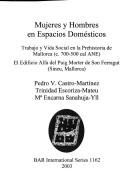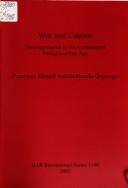Book
ISBN: 9781785707483 9781785707490 1785707493 1785707485 1785707515 9781785707513 Year: 2018 Publisher: Oxford : Oxbow Books,
Abstract | Keywords | Export | Availability | Bookmark
 Loading...
Loading...Choose an application
- Reference Manager
- EndNote
- RefWorks (Direct export to RefWorks)
In many regions of Europe and beyond fortifications belong to the most impressive of archaeological remains. Their study has a long tradition and today a multitude of aspects about architecture, function or symbolism has been explored. However, fortifications are generally examined in a temporally, regionally or culturally limited context. Going a step further, this volume aims to bring into focus concepts of fortifications, which can be socially, symbolically or functionally, but also chronologically and supra-regionally aligned. An important question is to determine which fortification elements are culture-specific, and which can be regarded as convergence or even universal phenomena. Adopting a comparative view, the central aim of the volume is to highlight the diversity and the structural similarities of ancient fortifications. The chronological framework goes from the Neolithic to the Late Iron Age, and the geographical scope from the Near East to the Iberian Peninsula.
Fortification, Prehistoric. --- HISTORY / Ancient / General. --- Fortification, Prehistoric --- Hill-forts --- Prehistoric fortification --- Archaeology
Book
Year: 1984 Publisher: Villeneuve d'Ascq : Revue du Nord,
Abstract | Keywords | Export | Availability | Bookmark
 Loading...
Loading...Choose an application
- Reference Manager
- EndNote
- RefWorks (Direct export to RefWorks)
Celts --- Celts --- Excavations (Archaeology) --- Excavations (Archaeology) --- Fortification, Prehistoric --- Fortification, Prehistoric --- Congresses --- Congresses --- Congresses --- Congresses --- Congresses --- Congresses
Book
Year: 1954 Publisher: Dundalk : Dundalgan press,
Abstract | Keywords | Export | Availability | Bookmark
 Loading...
Loading...Choose an application
- Reference Manager
- EndNote
- RefWorks (Direct export to RefWorks)
Megalithic monuments --- Fortification, Prehistoric. --- Antiquities. --- Fortification, Prehistoric. --- Megalithic monuments. --- Tara (Ireland) --- Ireland --- Ireland. --- Ireland --- Antiquities. --- Antiquities.
Book

ISBN: 9782364791565 2364791561 Year: 2023 Publisher: Dijon 01-Perronas APRAB impr. SEPEC.
Abstract | Keywords | Export | Availability | Bookmark
 Loading...
Loading...Choose an application
- Reference Manager
- EndNote
- RefWorks (Direct export to RefWorks)
Guerre, violence, opportuniste ou ritualisée, crispation territoriale, expression de la force et du pouvoir sont des notions fréquemment mises en avant pour caractériser l'âge du Bronze, époque marquée par une accélération des processus de hiérarchisation des sociétés. À travers quatre sessions, l'objectif de ce colloque sera de discuter ces considérations à partir de sources relatives à l'organisation, individuelle ou collective, technique ou symbolique, des manifestations de violence et de guerre.
Bronze age --- Bronze age --- Weapons, Prehistoric --- Weapons, Prehistoric --- Fortification, Prehistoric --- Fortification, Prehistoric
Book
ISBN: 1909686271 1909686255 Year: 2009 Publisher: Oxford, UK : Windgather Press,
Abstract | Keywords | Export | Availability | Bookmark
 Loading...
Loading...Choose an application
- Reference Manager
- EndNote
- RefWorks (Direct export to RefWorks)
Of all Britain's great archaeological monuments the Iron Age hillforts have arguably had the most profound impact on the landscape, if only because there are so many; yet we know very little about them. Were they recognised as being something special by those who created them or is the 'hillfort' purely an archaeologists' 'construct'? How were they constructed, who lived in them and to what uses were they put? This book, which is richly illustrated with photography of sites throughout England and Wales, addresses these and many other questions. After discussing the difficult issue of definitio
Earthworks (Archaeology) --- Earthworks (Archaeology) --- Fortification, Prehistoric --- Fortification, Prehistoric --- Iron age --- Iron age --- England --- Wales --- Antiquities. --- Antiquities.
Book
ISBN: 1784917168 9781784917166 Year: 2017 Publisher: Summertown, Oxford
Abstract | Keywords | Export | Availability | Bookmark
 Loading...
Loading...Choose an application
- Reference Manager
- EndNote
- RefWorks (Direct export to RefWorks)
This volume sets out the results of a detailed programme of non-intrusive geophysical survey conducted across hillforts of Dorset (UK), generating detailed subsurface maps of archaeological features, in the hope of better resolving the phasing, form and internal structure of these iconic sites.
Fortification, Prehistoric --- Geophysics in archaeology. --- Dorset (England) --- Antiquities.

ISBN: 1841715301 Year: 2003 Publisher: Oxford : Archaeopress,
Abstract | Keywords | Export | Availability | Bookmark
 Loading...
Loading...Choose an application
- Reference Manager
- EndNote
- RefWorks (Direct export to RefWorks)
Bronze age --- Excavations (Archaeology) --- Fortification, Prehistoric --- Iron age --- Talayots

ISBN: 1841715638 Year: 2003 Publisher: Oxford : Archaeopress,
Abstract | Keywords | Export | Availability | Bookmark
 Loading...
Loading...Choose an application
- Reference Manager
- EndNote
- RefWorks (Direct export to RefWorks)
Excavations (Archaeology) --- Fortification, Prehistoric --- Iron age --- Warfare, Prehistoric
Book
ISBN: 9781407311234 Year: 2013 Publisher: Oxford : Archaeopress,
Abstract | Keywords | Export | Availability | Bookmark
 Loading...
Loading...Choose an application
- Reference Manager
- EndNote
- RefWorks (Direct export to RefWorks)
Fortification, Prehistoric --- Iron age --- Landscape archaeology --- Ceredigion (Wales) --- History, Military.
Book
ISBN: 189781707X Year: 1993 Publisher: S.l. : Horace books,
Abstract | Keywords | Export | Availability | Bookmark
 Loading...
Loading...Choose an application
- Reference Manager
- EndNote
- RefWorks (Direct export to RefWorks)
Britons --- Fortification, Prehistoric --- Iron age --- Monuments --- Guidebooks. --- Guidebooks --- Guidebooks

 Search
Search Feedback
Feedback About UniCat
About UniCat  Help
Help News
News